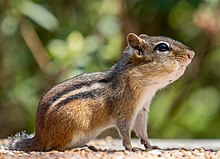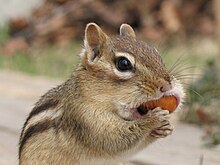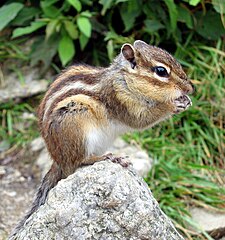Chipmunk
| Chipmunk Temporal range: Early Miocene to Recent | |
|---|---|

| |
| Eastern chipmunk (Tamias striatus) | |
| Scientific classification | |
| Domain: | Eukaryota |
| Kingdom: | Animalia |
| Phylum: | Chordata |
| Class: | Mammalia |
| Order: | Rodentia |
| Family: | Sciuridae |
| Subfamily: | Xerinae |
| Tribe: | Marmotini Illiger, 1811[1] |
| Genera | |
|
3, see text | |
Chipmunks are small, striped rodents of Sciuridae, the squirrel family; specifically, they are ground squirrels (Marmotini). Chipmunks are found in North America, with the exception of the Siberian chipmunk which is found primarily in Asia.
Taxonomy and systematics
Chipmunks may be classified either as a single genus, Tamias, or as three genera: Tamias, of which the eastern chipmunk (T. striatus) is the only living member; Eutamias, of which the Siberian chipmunk (E. sibiricus) is the only living member; and Neotamias, which includes the 23 remaining, mostly western North American, species. These classifications were treated as subgenera due to the chipmunks' morphological similarities.[2] As a result, most taxonomies over the twentieth century have placed the chipmunks into a single genus. However, studies of mitochondrial DNA show that the divergence between each of the three chipmunk groups is comparable to the genetic differences between Marmota and Spermophilus,[2][3] so the three genera classifications have been adopted here.
- Tamias striatus, Eastern chipmunk
- Eutamias sibiricus, Siberian chipmunk
- Neotamias minimus, Least chipmunk
The common name originally may have been spelled "chitmunk", from the native Odawa (Ottawa) word jidmoonh, meaning "red squirrel" (cf. Ojibwe ᐊᒋᑕᒨ ajidamoo).[4][5] The earliest form cited in the Oxford English Dictionary is "chipmonk", from 1842. Other early forms include "chipmuck" and "chipminck", and in the 1830s they were also referred to as "chip squirrels", probably in reference to the sound they make. In the mid-19th century, John James Audubon and his sons included a lithograph of the chipmunk in their Viviparous Quadrupeds of North America, calling it the "chipping squirrel [or] hackee".[6] Chipmunks have also been referred to as "ground squirrels"[7] (although the name "ground squirrel" may refer to other squirrels, such as those of the genus Spermophilus).[8]
Diet

Chipmunks have an omnivorous diet primarily consisting of seeds, nuts and other fruits, and buds.[9][10] They also commonly eat grass, shoots, and many other forms of plant matter, as well as fungi, insects and other arthropods, small frogs, worms, and bird eggs. They will also occasionally eat newly hatched baby birds.[9][10][11] Around humans, chipmunks can eat cultivated grains and vegetables, and other plants from farms and gardens, so they are sometimes considered pests.[9][12] Chipmunks mostly forage on the ground, but they climb trees to obtain nuts such as hazelnuts and acorns.[9][13] At the beginning of autumn, many species of chipmunk begin to stockpile nonperishable foods for winter. They mostly cache their foods in a larder in their burrows and remain in their nests until spring, unlike some other species which make multiple small caches of food.[9] Cheek pouches allow chipmunks to carry food items to their burrows for either storage or consumption.[10]
Ecology and life history

Eastern chipmunks, the largest of the chipmunks,[14] mate in early spring and again in early summer, producing litters of four or five young twice each year.[9] Western chipmunks breed only once a year. The young emerge from the burrow after about six weeks and strike out on their own within the next two weeks.[15]
These small mammals fulfill several important functions in forest ecosystems. Their activities harvesting and hoarding tree seeds play a crucial role in seedling establishment. They consume many different kinds of fungi, including those involved in symbiotic mycorrhizal associations with trees, and are a vector for dispersal of the spores of subterranean sporocarps (truffles) in some regions.[16]
Chipmunks construct extensive burrows which can be more than 3.5 m (11 ft) in length with several well-concealed entrances.[17] The sleeping quarters are kept clear of shells, and feces are stored in refuse tunnels.[18]
The eastern chipmunk hibernates in the winter, while western chipmunks do not, relying on the stores in their burrows.[19]
Chipmunks play an important role as prey for various predatory mammals and birds but are also opportunistic predators themselves, particularly with regard to bird eggs and nestlings, as in the case of eastern chipmunks and mountain bluebirds (Siala currucoides).[20]
Chipmunks typically live about three years, although some have been observed living to nine years in captivity.[21]
Chipmunks are diurnal. In captivity, they are said to sleep for an average of about 15 hours a day. It is thought that mammals which can sleep in hiding, such as rodents and bats, tend to sleep longer than those that must remain on alert.[22]
Genera
Genus Eutamias
- Siberian chipmunk, Eutamias sibiricus
- Eastern chipmunk, Tamias striatus
- †Tamias aristus
Genus Neotamias
- Allen's chipmunk, Neotamias senex
- Alpine chipmunk, Neotamias alpinus
- Buller's chipmunk, Neotamias bulleri
- California chipmunk, Neotamias obscurus
- Cliff chipmunk, Neotamias dorsalis
- Colorado chipmunk, Neotamias quadrivittatus
- Durango chipmunk, Neotamias durangae
- Gray-collared chipmunk, Neotamias cinereicollis
- Gray-footed chipmunk, Neotamias canipes
- Hopi chipmunk, Neotamias rufus
- Least chipmunk, Neotamias minimus
- Lodgepole chipmunk, Neotamias speciosus
- Long-eared chipmunk, Neotamias quadrimaculatus
- Merriam's chipmunk, Neotamias merriami
- Palmer's chipmunk, Neotamias palmeri
- Panamint chipmunk, Neotamias panamintinus
- Red-tailed chipmunk, Neotamias ruficaudus
- Siskiyou chipmunk, Neotamias siskiyou
- Sonoma chipmunk, Neotamias sonomae
- Townsend's chipmunk, Neotamias townsendii
- Uinta chipmunk, Neotamias umbrinus
- Yellow-cheeked chipmunk, Neotamias ochrogenys
- Yellow-pine chipmunk, Neotamias amoenus
In popular culture
- Alvin and the Chipmunks, an animated virtual band
- Chip 'n' Dale, cartoon Disney chipmunks
References
- ^ Illigeri, Caroli (1811). "Genus 34. Tamias (ταμιας promus condus) Bakkenhörnchen". Prodromus systematis mammalium et avium. Berlin: C. Salfeld. p. 83.
- ^ a b Patterson, Bruce D.; Norris, Ryan W. (2016). "Towards a uniform nomenclature for ground squirrels: the status of the Holarctic chipmunks" (PDF). Mammalia. 80 (3): 241–251. doi:10.1515/mammalia-2015-0004. S2CID 9955150. Archived (PDF) from the original on 2019-06-08. Retrieved 2019-06-08.
- ^
- Wilson, D. E.; D. M. Reeder (2005). "Mammal Species of the World". Archived from the original on 2007-06-23. Retrieved 2007-06-27.
- Piaggio, A. J.; Spicer, G. S. (2001). "Molecular phylogeny of the chipmunks inferred from mitochondrial cytochrome b and cytochrome oxidase II gene sequences" (PDF). Molecular Phylogenetics and Evolution. 20 (3): 335–350. Bibcode:2001MolPE..20..335P. CiteSeerX 10.1.1.330.9046. doi:10.1006/mpev.2001.0975. PMID 11527462. Archived (PDF) from the original on 2012-08-23.
- Piaggio, Antoinette J.; Spicer, Greg S. (2000). "Molecular Phylogeny of the Chipmunk Genus Tamias Based on the Mitochondrial Cytochrome Oxidase Subunit II Gene" (PDF). Journal of Mammalian Evolution. 7 (3): 147–166. doi:10.1023/a:1009484302799. S2CID 7623018. Archived (PDF) from the original on 2011-09-13.
- Musser, G. G.; Durden, L. A.; Holden, M. E.; Light, J. E. (2010). "Systematic review of endemic Sulawesi squirrels (Rodentia, Sciuridae), with descriptions of new species of associated sucking lice (Insecta, Anoplura), and phylogenetic and zoogeographic assessments of sciurid lice" (PDF). Bulletin of the American Museum of Natural History. 339 (339): 1–260. doi:10.1206/695.1. hdl:2246/6067. S2CID 82712592. Archived (PDF) from the original on 2018-04-30.
- ^ "Online Etymology Dictionary". Etymonline.com. Retrieved 7 December 2012.
- ^ Nichols, John D. and Earl Nyholm (1995). A Concise Dictionary of Minnesota Ojibwe. Minneapolis: University of Minnesota Press.
- ^ Audubon, John James; Bachman, John (1967). Imperial Collection of Audubon Mammals. New York: Bonanza Books, a division of Crown Publishing Group. p. 52.
- ^ Chisholm, Hugh, ed. (1911). . Encyclopædia Britannica. Vol. 12 (11th ed.). Cambridge University Press. p. 626.
- ^ Kryštufek, B.; B. Vohralík (2013). "Taxonomic revision of the Palaearctic rodents (Rodentia). Part 2. Sciuridae: Urocitellus, Marmota and Sciurotamias". Lynx, N. S. (Praha). 44: 22.
- ^ a b c d e f Hazard, Evan B. (1982). The Mammals of Minnesota. University of Minnesota Press. pp. 52–54. ISBN 978-0-8166-0952-9.
- ^ a b c "West Virginia Wildlife Magazine: Wildlife Diversity Notebook. Eastern chipmunk". Wvdnr.gov. Retrieved 2012-12-07.
- ^
- "Eastern Chipmunk - Tamias striatus - NatureWorks". Nhptv.org. Retrieved 2012-12-07.
- Linzey, A.V.; NatureServe (2008). "Tamias minimus". IUCN Red List of Threatened Species. 2008. Retrieved 2012-08-29.
- Linzey, A.V.; NatureServe (2008). "Tamias sibiricus". IUCN Red List of Threatened Species. 2008. Retrieved 2012-08-29.
- Linzey, A.V.; NatureServe (2008). "Tamias townsendi". IUCN Red List of Threatened Species. 2008. Retrieved 2012-08-29.
- ^ "Chipmunks | Living With Wildlife". Mass Audubon. Archived from the original on 2012-12-18. Retrieved 2012-12-07.
- ^ "Chipmunk at Animal Corner". Animalcorner.co.uk. 2004-01-01. Retrieved 2012-12-07.
- ^ "National Geographic". National Geographic Society. 11 April 2010. Archived from the original on 2021-03-01.
- ^ Schwartz, Charles Walsh; Elizabeth Reeder Schwartz; Jerry J. Conley (2001). The Wild Mammals of Missouri. University of Missouri Press. pp. 135–140. ISBN 978-0-8262-1359-4.
- ^ Pyare, Sanjay; Longland, William S. (2001). "Patterns of Ectomycorrhizal-Fungi Consumption by Small Mammals in Remnant Old-Growth Forests of the Sierra Nevada". Journal of Mammalogy. 82 (3): 681–689. doi:10.1644/1545-1542(2001)082<0681:POEFCB>2.0.CO;2. ISSN 0022-2372. JSTOR 1383605.
- ^ Saunders, D. A. (1988). "Eastern Chipmunk". Adirondack Mammals. Adirondack Ecological Center. Retrieved 2015-09-19.
- ^ Leslie Day (October 2007). Field Guide to the Natural World of New York City. Johns Hopkins University Press. ISBN 9780801886829. Retrieved 2015-09-19.
- ^ Kays, R. W.; Wilson, Don E. (2009). Mammals of North America (2nd ed.). Princeton University Press. p. 72. ISBN 978-0-691-14092-6.
- ^ Sullivan, Janet. "WILDLIFE SPECIES: Sialia currucoides". Fire Effects Information System, [Online]. U.S. Department of Agriculture, Forest Service, Rocky Mountain Research Station, Fire Sciences Laboratory. Retrieved 23 January 2016.
- ^ "Information on Chipmunks". Essortment.com. 1986-05-16. Archived from the original on 2012-12-22. Retrieved 2012-12-07.
- ^ Jennifer S. Holland "40 Winks?" (July 2011). National Geographic Vol. 220, No. 1.
- ^ Tamias, Mammal Species of the World, 3rd ed.
Further reading
- Baack, Jessica K.; Switzer, Paul V. (December 2003). "Alarm Calls Affect Foraging Behavior in Eastern Chipmunks (Tamias Striatus, Rodentia: Sciuridae)". Ethology. 106 (12): 1057–1066. doi:10.1046/j.1439-0310.2000.00619.x. Derived from Baack's master's thesis.
- Gordon, Kenneth Llewellyn (1943). The Natural History and Behavior of the Western Chipmunk and the Mantled Ground Squirrel. Oregon State College Monographs. Studies in zoology, no. 5. Corvallis, Or.: Oregon State College. LCCN 44053700. OCLC 752445896.
External links
- Wildlife and Nature – Chipmunk at the Wayback Machine (archived April 24, 2008)



